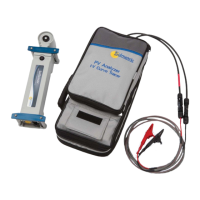1 Getting Started
2-56
Over-current can occur when:
1. Measuring too many strings in parallel
2. Measuring strings that are still electrically connected to the rest of the array or the
inverter (for example, when the combiner box DC disconnect is not opened), and
3. Measuring more than one string of high efficiency PV modules at a time (that is,
connected in parallel).
High-efficiency modules produce a short but intense pulse of current at the start of every
I-V curve measurement. The I-V Unit is designed to tolerate that intense pulse from a
single high-efficiency module or string, but measuring two or more in parallel will
damage the instrument.
CAUTION Do not measure high-efficiency PV modules (or strings) in parallel.
Reverse Polarity Protection
If the I-V Measurement Unit is connected with the wrong polarity across a string, an
internal protection diode opens the circuit, the I-V Measurement Unit switches into
disabled mode, and an I-V measurement does not take place. The software also posts the
warning "Voltage Out of Range. If the magnitude of the applied DC voltage exceeds the
specified maximum voltage of the instrument, there is also the possibility of internal
damage. See “Over Voltage Warnings.”

